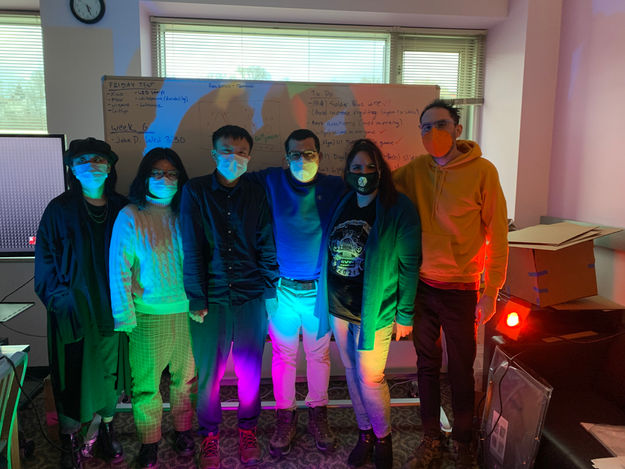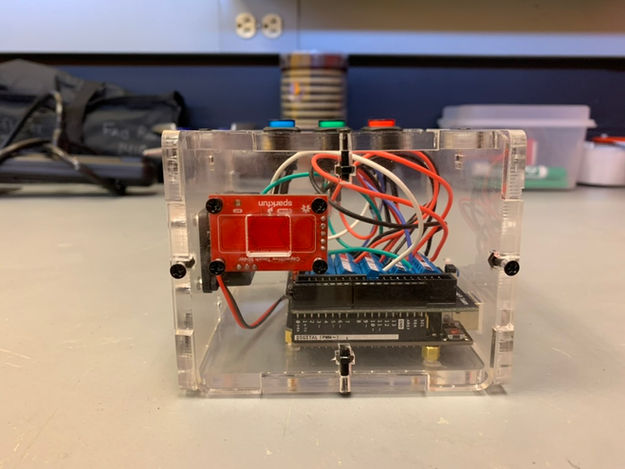
Colorize
Hardware prototype game and activities exploring the art and science of color through the use of light.
Overview
Time Frame: 14 Weeks
Date: January 2022 - May 2022
Team Size: 6
Team Members: Caitlyn Lenhoff, Max Cameron, Xiao Han, Wizard Hsu, Ebrahim Karam, Qin Zhang
Client: Lou Karas, WLU Center for Arts and Education
Role: Designer (Experience / Gameplay)
Tools: Unity
Keywords: Hardware, Color, Light
Description:
Colorize is a project at CMU’s Entertainment Technology Center with a goal to create hardware prototypes and documentation for activities that will introduce elementary school students in K- 2nd grade to the colors of the light spectrum and light color mixing. The project was built for West Liberty University’s Center for Arts and Education. It includes four separate hardware activities: The LED Musical light strip that introduces additive mixing to make secondary colors, The whiteboard activity that introduces the ideas of absorption and refraction, the shadow puppet activity that introduces additive color theory and color mixing using the difference between shadows and light, and the color wheel activity that introduces the additive color wheel and additive color mixing to make tertiary colors.
Duties/Personal Contributions:
-
Experience designer for all activities but the LED light strip
-
Gameplay designer for all activities but the LED light strip
-
Concept artist of initial designs
-
In charge of creating rapid prototypes of the activities in Unity so that we could playtest the mechanics.
Demos
LED Light strip

Shadow Puppets

Whiteboard

Color Wheel

Process
Concept Design
As the designer I mostly did the duty of setting the groundwork for the activities that we were going to explore. For this I would propose activities and how they would possibly work as well as make simplistic concept art of what they may possibly look like.
I would then update these concepts and design new ones based on the needs of our playtesters after each playtest. For example, after our first playtest, we saw that the color puzzle was too challenging but the idea of introducing the tertiary level colors was catching interest, so I worked on making potential activity concepts that would eventually lead to the color wheel activity.
I was also in charge of making rapid software prototypes for some of the hardware intensive activities so that we could test the mechanics before we wasted materials making a hardware activity that was not engaging for our audience.




Color Wheel
During the course of the project, one activity in particular needed multiple redesigns. This activity was the one that we intended to have introduce tertiary colors of the additive color wheel.
The first concept was a color matching puzzle where the guest would tap buttons to rotate through colors of the primary and secondary levels of the additive color wheel and try to find the two colors that matched the color given below the buttons. This was interesting for the guests, but too challenging and not engaging. So I ended up designing a new activity based off of it, but less rigid.
This next activity was the Make-A-Rainbow activity. It was still a color puzzle activity, but it no longer had a wrong answer. The goal of the activity was to tap the red, green, and blue buttons in random orders until you filled a strip of four lights. Once this was filled, the colors in that strip would fill a light above it with the color that they mix to. For example, one green light and three red lights would make an orange light. The activity, though more engaging, also still felt like it was lacking a form factor or purpose for playing.
I then designed the Make-A-Rainbow activity to be a firework shape, so that guest would feel that rather than just filling a random strip, they were designing their own firework. However, when translating this into hardware we saw complications due to hardware limitations, and the form still did not have enough meaning.
Finally this is when I designed the concept for the color wheel activity. It shared the concept of filling four lights in a strip that would blend to make the final color, but the color was added to a color wheel. The color wheel allowed guests to learn not only the tertiary colors, but how they, the primary, and the secondary colors all relate to the color wheel in general. This change in the form factor allowed us to get the meaning that we were looking for.






